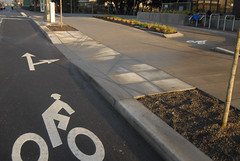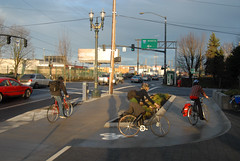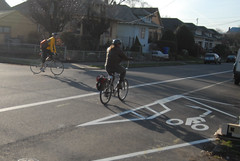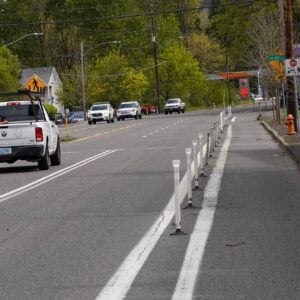When you’re riding a bicycle, making a left turn across several lanes isn’t the easiest thing to do, especially for less-confident riders. To help make the maneuver a bit more pleasant, it’s sometimes helpful to do what traffic engineers refer to as a “two-stage left turn” (it’s also referred to as a “Copenhagen Left” or “box turn.”)
Markings and infrastructure for two such left turn movements have recently popped up in Portland.
On N. Vancouver Avenue at Going, PBOT has striped a two-stage left turn (see photo at right) to help southbound bike riders position themselves to head east on Going. According to PBOT project manager Kyle Chisek, the new striping gives less confident riders a “place to pull out of he bike lane so they don’t impede bike traffic and have a refuge to wait before crossing.” Chisek also pointed out that anyone who feels comfortable enough to take the lane is still welcome to do so.
There’s also a new two-stage left turn treatment at N. Weidler and Williams. This location sees very heavy bike traffic in the evenings. A construction project on the corner recently removed the sidestreet previously used by eastbound bike traffic to better position themselves to go north on Williams. The project (a affordable housing building) is now completed and PBOT worked with the developers to build a custom cut-through. The result is a deluxe two-stage left turn facility:

Looking east on Weidler, the arrow points the way.
|

Looking west toward Weidler, riders roll out onto Williams (a one-way street).
|
The only problem with the above solution, is that many riders don’t yet seem to notice it as they ride by.
These aren’t the only places in town with two-stage left turns. PBOT also installed one on the cycle track on Broadway near Portland State University.









Thanks for reading.
BikePortland has served this community with independent community journalism since 2005. We rely on subscriptions from readers like you to survive. Your financial support is vital in keeping this valuable resource alive and well.
Please subscribe today to strengthen and expand our work.
one of the things that is getting missed in these great ideas is the curb “ramp” – they tend to force a sharp right-turn, almost 90 degrees. (this is also true of the eastbound ramp onto the Hawthorne Bridge: you have to make a serious right-left dogleg that isn’t much fun at night in the rain.)
granted this slows bikes down but safe bicycling is enhanced by fewer quick, sharp turns. if they can build smoother approaches to these things, it will help quite a bit. that they are building these things at all, of course, is truly awesome. i wanna go ride up Williams just to make a left turn!
Way OVER-engineered. FAIL. When “unsafe” is SAFER.
Paul (#2) – You haven’t ridden this intersection, or if you have, it was 2 Pedalpaloozas ago. The trafic here sucks, and the previous “solution” sucked more. This is way better than what used to be there.
@ Pau Tay (# 2):
The reason we must engineer traffic helps like this is because American society just isn’t as tuned into a social compact as most European societies are. Hitting a person on a bike with your car is unthinkable and even a source of shame in many European cities. Here’s it’s just an “unfortunate accident”.
Removing traffic signs would be the bigger failure here, which is why no US City has yet tried such a tack.
I have used the turn aide to help me get onto Williams and I find it useful and helpful.
Progress is progress.
I ride this intersection more than once daily and am quite pleased that this treatment has been done. There was something similar in place during construction which also worked. It’s great and needed when loaded with cargo or kids.
And Paul#2, I hear you, it would be superb if distracted American drivers would pay the appropriate amount of respect to the task at hand but alas we are not there yet.
t.a. barnhart #1:
Agreed that the 90 degree alignment with the ramp at Weidler-Williams is less than ideal for smooth bike movement and truly it wasn’t something we considered in the design. In this instance it’s probably good to have it as it is because this area–near the main entrance to the building–is also expected to have a lot of pedestrians. That was a concern about this area so it’s probably good that the design requires a slower speed.
In future designs that are not in pedestrian areas we’d want a shallower approach allowing for a smoother move.
I don’t like or use the swerve-and-bob type of bike engineering that seems to be popping up everywhere, so I’m glad I can still use the big expensive traffic light and nice wide left turn lane that has been there for years. This type of detour is fine solution for a temporary construction site.
I hope this latest change encourages more able bodied folks to ride bikes down town instead of drive cars.
If you guys say so….Damn, my head hurts trying to figure what da beef is from the photos.
You guys don’t give enough credit to cagers. As far as I know, they are still of the homo sapien species, right. When homo sapiens get confused, either in a cage or bike, guess what? They slow down.
Mass confusion as traffic control device? Naaaaaaaaaaaaah.
Paul,
I do give cagers some credit but for this particular intersection with 3 lanes going uphill and rolling on a cargo bike, often with my kids on board, I’m taking the less vehicular approach. There are a bunch of freeway on/off sections in the immediate area and some people are likely to be in the “freeway mindset.” not to mention rolling beyond the speed limit.
With high bike traffic, you’re seeing about a 10% split where cyclists opt for the far left lane for the left turn, me being among them when on my fast commuter rig. The route is not confusing at all, the arrows make everything clear. It’s all good.
Regarding the left turn at Weidler. Does that feeder actually cut across a sidewalk? I doubt that there’s much in sidewalk traffic there, but still it seems awkward.
I haven’t seen that intersection much in a long while. When construction started there, I started avoiding that intersection.
Coming up Broadway, I’ll use a red light to cross the Broadway before it forks to the Weidler couplet; I go to the north sidewalk on Broadway. From there I leisurely ride up slow until I get to Flint. It cuts out some distance, it cuts out the bicycle traffic jams at Weidler-Williams. And on Blazer nights, it keeps me away from the parking lot crazies that make unpredictable moves in their cars near the Rose Quarter.
Are these designed just for turning left onto one-way streets? I hope Going is one-way there, as the turn-out perches the rider on the left side of the road facing East? Is this right? [Hard to tell from one photo].
I agree with the ‘Copenhagen left’ – do it all the time – clearly the safest way to make a left in a busy intersection.
Perhaps we just need an education campaign about the maneuver – this seems like a solution looking for a problem.
I know there’s always a long list of design considerations … but placing the rider in the right place [left side of the road is not the right place], would seem paramount.
i am well within what the facilities crowd calls intrepid or whatever, and i do often cross three lanes to make a left from weidler onto williams, but sometimes the traffic is such that you find yourself still over on the right as you approach the intersection and the box right is sort of thrust upon you. having the turnout here was useful in the past, and it will be good to have it back. but i am anxious about the statement that if it exists you are not required to use it. seems to me 814.420 could easily be construed to cover this facility.
The new Weidler-Williams two-stage left is nice, but it doesn’t seem like a complete treatment.
My concerns are
1. This further exacerbates conflicts between people walking and people biking (you can see this on any of our MUP’s or the steel bridge scramble crossing). We are now taking space away from peds, I don’t like this sort of precedent
2. At times, this still requires that you ride *the wrong way* against traffic on Williams to queue up. It would have been nice to see a huge bike box or other accomodation that would put bikes as first priority on Williams rather than the tiny sliver that’s been given here. I know they have to accommodate for buses and large trucks, but keeping traffic back about 15 feet would avoid some of the wrong-way riding.
3. As seen in the photo above, now folks are racing onto the sidewalk early, before the cut out, so you’ve got another right-side collision risk when you enter the sidewalk.
I understand biking on the sidewalk is legal in this part of Portland, but I’m concerned that this sort of treatment encourages cyclists to encroach on an already very limited space for people walking.
I hope when the new cycletrack is built here, they’ll address these issues. I do really like that since the construction there is less pavement and more plants here.
Love it. Cant wait to ride through it.
Whatever happened to merging over to the left? I don’t like the suggestion that as a bicyclist, I need a “refuge to wait” on the road. These “two-stage turns” are dumb, slower than necessary, and I won’t use them.
While I think the “box turn” towards the right is an effective engineering solution to encourage people to make left turns they are more comfortable with, I hesitate in this instance due to the fact that bikes are prompted to cut across sidewalks.
Perhaps there could be some marking on the pavement alerting those that bike of those that are walking on the sidewalk? I would not like to see this turn into a potential conflict zone between those that bike and those that walk.
I ride through this everyday and it’s TERRIBLE! Clearly, whoever designed it doesn’t actually ride a bike. A 90 degree turn to the right and then immediately a 90 degree turn to the left.. and all on slippery pavement? Seriously? It’s so bad that I prefer not to use it. Would it really have been that hard to make it functional for us?
I wish I could I find the video of the scooters in Taiwan doing ‘Copenhagen’ left turns.
When they do it, there is basically NO infrastructure needed, just a bike box where cars are not allowed to enter at a red light.
It works marvelously well for scooters battling 8 lane super roads in making a left turn.
Does this consist of turning right on the street you actually want to go left on, doing a U-turn, and then going straight? I see people do that around here sometimes.
I’m going to have to agree that this isn’t a good solution. I predict that perhaps 30% of cyclists will use it. It just complicates the intersection. This type of of infrastructure may work well in denmark or tokyo, but I think those folks are more used to following strict rules and structures.
Anyway, what ever the reason is, I doubt it will catch on. It’s just a facelift of the same thing that was there before that nobody ever used. I’m still going to either take the flint shortcut, merge left across lanes, or ride the bike lane till I hit williams & then turn left at the light.
Hopefully this type of design will encourage new cyclists to ride more and feel safer, but I think most experienced cyclists will ignore it.
Jughandle turn 🙂
Was delighted to find it on my ride from downtown to visit friends in North Portland last night. They call ’em jug handles in NJ, where they are commonly used for cars.
John (#11) — Yes it does cut across a sidewalk. The building at N. Weidler is the Madrona, a new Central City Concern-owned property, that has quite a few studio apartments and will also be the new home of Hooper Detox (also run by CCC). Between the residents & visitors, and the clinic, there will probably be a reasonable amount of foot traffic there before too long.
Maybe more bike signals ?
Info here from the transportation site:
http://www.portlandonline.com/TRANSPORTATION/index.cfm?c=35899
I would recommend checking out the green left turn boxes along the SW Broadway cycletrack @ PSU (mentioned in the article).
I use them almost every day and I love them. They are simple and user-friendly and could be replicated all over the city with minimal cost (it’s just paint!) and easily connected to the larger bike boxes at major intersections.
now that i have actually tried it, i have to second comments 14 and 18. the design is horrible. you essentially have to slow to a crawl out on weidler before hanging the ninety degree right or you will overshoot the path entirely and end up taking the sidewalk. also, there is another curb cut a few feet in advance which anyone wanting to avoid what i have just described will want to take, creating conflicts as the path crosses the sidewalk. complete fail, as the computer kids say. i might grudgingly use this if i am completely unable to merge left ahead of the intersection, but would more likely just bike across the intersection and set up my own impromptu copenhagen left.
I make a Woodstock left evry morning and a Woodstock right every evening.
I used this thing today. I didn’t have a problem so much with the 90 degree turn since I wasn’t going very fast on my 40lb. 3-speed, but it’s interesting where it dumps you out. I was expecting a bike box or something that allowed me to cut across to the bike lane on the other side of the street. 3 or 4 other folks rolled through there on their bikes – 2 of them continued though the intersection then set up for their left turn, and 2 of them used the sidewalk alongside the cut-through. So it seemed that it’s not obvious, or that it’s inconvenient. I don’t know, it’s a great idea, but I think the approach could have been executed better and where it puts you onto Williams is a bit of a mystery.
re comment 29. yes, there should be a stop sign at the end so people don’t just dump out onto williams in front of a bus or something. very poor design all around. the person i was riding with did what the cyclist on the red bike is doing in the top photo — took the sidewalk –, which is a perfectly rational approach to the facility, but of course will not work with pedestrians around . . .
Paul Tay (@ #2):
I rarely ride through this intersection and haven’t seen this new facility, so I can’t comment directly on whether it is ‘over-engineered’ for the conditions there. However, the article that you link to is hardly an example of minimal engineering — in fact that approach is highly engineered.
The town is implementing what’s called Shared Space, and as the Spiegel article mentions, it involves a complete redesign and rebuilding of the roadway and sidewalks — it is in no way simply ‘removing all the signs’ from an existing roadway. Furthermore, even its proponents differentiate between ‘slow’ zones, where it is appropriate, and ‘fast’ roads, where it is generally not appropriate. At 25,000+ cars a day, many of whom are trying to reach I-5 as quickly as possible, NE Weidler is probably not a suitable candidate for Shared Space treatment.
As an aside (Beth @ #4), while I don’t disagree with your comments regarding the difference in ‘social compacts’ between the US and Europe, that’s ultimately not the reason that these Shared Space treatments work there. It has much more to do with redesigning roadways in such a way that their very ambiguity forces users to negotiate right-of-way with each other, instead of being able to assume that the road belongs to them until a stop sign tells them otherwise. And it has been done in the US, at least partially: in West Palm Beach, and apparently quite successfully. ( Here is an interesting blog post by a New Jersey DOT traffic engineer about experiencing the installations in Europe and discussions about how to apply them in the US.)
@Michael Andersen (Contributor) Miller, From the blog.pps.org, “Shared Space was pioneered by the late Dutch traffic engineer and PPS friend Hans Monderman.”
That statement is NOT true. Most of the third world has “shared space.” Visit any given intersection in Ho Chi Minh City, Yangon, or Zimbabwe. To Western eyes, I dare say they all look like a mass confusion of Chinese in a false alarm fire drill.
The reason why Western cities, especially Germany, have to COMPLETELY overhaul the public space to meet Shared Space standards is because of the Judeo-Christian mindset of rule of law, crime, and punishment applied to movement in the public space.
Where is the human element of simply looking out for each other, instead of looking out for signs, traffic signals, and laws? The West is simply trying to catch up with the Third World, as if it’s some sort of ah-Ha moment.
When traffic laws are promulgated, somebody, somewhere, sometime, WILL be CRIMINALIZED. The rule of law, sir, is way OVER-rated.
Re: the new treatment at Weidler/Williams. Looks great! Can’t wait to try it out!
To the naysayers – good luck cutting across & merging with four lanes of fast-flowing, fast-speeding, non-stop motor-vehicle traffic on your bike to make this left-hand turn. I mean, why use a simple solution, when a complicated one will do?!
When you’re riding a bicycle, making a left turn across several lanes isn’t the easiest thing to do, especially for less-confident riders.
Probably because you shouldn’t be making a left from the right curb lane. Merging to the center still sucks, but it’s still easier and safer than making an illegal left from the curb…
we need to get some google satellite pictures of this to figure out how its working. I am not familiar with this kind of left turn, however I like it very much and if it means one more person feels safer on a bike than its worth it. However I am slightly confused, you are going forward through the green light and if you did a lane left turn you would be well on your way, but now you have to stop and become cross traffic and wait for the green light your way… I am not sure I like that or that it is practical. If there were bike intersection lights here stopping all car traffic and letting bikes move through in all directions than maybe, but if that were the case then somebody who wanted to move left could do so since the cars were stopped…
I see very little pedestrian conflicts…
After checking this new “biking aide” out, I fail to see the need for it. What was wrong with simply riding up Weidler, nearly cross Williams and then looping into the que and waiting for the light to change to proceed on Williams? This is an effective route with no need to cross traffic lanes to make the left turn. I have completed this action with and without my child in tow and felt completely comfortable. I don’t see myself using this fancy new turning route, it seems to disrupt the flow of the ride. I am embarrassed to think about how much it must of cost when many streets could simply use some basic repaving or repairing.
@Paul Tay #9: True, regarding species. Untrue in suggesting we have commonality beyond that. With two out of three people in Portland being Californian tourists who forgot to leave when they’re done visiting, and California’s overall low IQ and horrifically lax licensing standards, is it any surprise that bad habits are hard for the tourists to break once they’re here?
@steve #14: So would convincing our legislature to do the right thing and ban riding on the sidewalks statewide.
i ride here every day. i have noticed this change and have been trying to adapt to it. i have tried several ways of using it and none of them are comfortable or use it the way it’s intended. it really needs to be re-done (or no one will use it).
the two main problems:
(1) the 90-deg right hand turn to get into the special lane is DIFFICULT because of how sudden it is (even at uphill, just-leaving-the-intersection pace). there needs to be some acknowledgement of a diagonal approach.
(2) additionally, the curb cut lip adds a measure of danger in that it is parallel to your wheel since you are already close to the gutter when you initiate your turn. i expect someone to fall here soon because the tire slips off the edge as the rider leans into the turn.
please make it better and we will gladly use it!!
We call this a “jug handle” out here in Jersey.
BTW, I don’t think the design in the first or third photo’s is ADA compliant. To prevent blind people from walking out into the street anywhere where the sidewalk ramps down to the street it is REQUIRED to have a mat of tactile, truncated domes and I don’t see it in the photo. However, I would be uncomfortable installing a mat of truncated domes in this situations since I think its dangerous for bicyclists to be forced to turn on those mats.
I think if they under-engineered this a little and kept the sidewalk to the right of the “jug handle” it would be a much better design.
@Andy #40: The mats should be parallel to where bikes cross the sidewalk (ie bikes don’t cross them) to provide warning that there’s a traffic lane there.